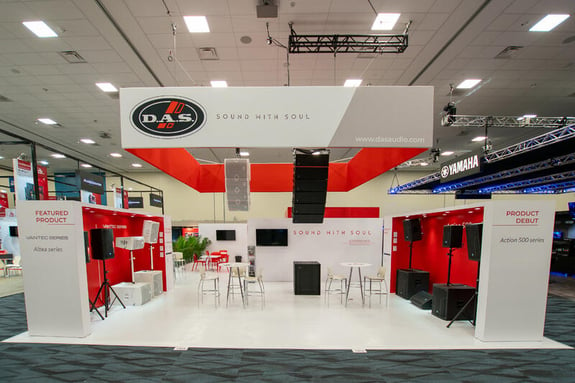Before giving your construction team the green light to start building your trade show booth, there are a few aspects that often get overlooked: show logistics compliance, transportation, and storage. Your booth will have to be delivered, constructed, dismantled, and stored. Factors like size, weight, show requirements, and special handling must be considered from the beginning of the design process — specifically because you don't want to find out that certain booth features do not fit the trade show's specific dimensional restrictions or are out of compliance with the venue.
Let's dive into what type of show logistics you need to know, where to find them, and how to best transport and store your booth for your next show...
What are the restrictions?
As you start working with trade shows, you will learn that certain venues have very specific restrictions for things like signage, setbacks from the aisle, booth height, and what type of technology or lighting is allowed. Before registering your company for a trade show, be sure to check their website or contact their show coordinator for the rules and regulations you'll need to adhere to. The extra time you spend researching the show's logistics before registering or finalizing your design plans will be well worth the peace of mind knowing that you won't have to pay hidden fees or unexpected costs later on.
Alternatively, first-time exhibitors can benefit from working with an experienced exhibit house with a design team that knows the importance of carefully reviewing the show rules and regulations in order to ensure the design meets all standards established by the venue.
Who's on your support team?
Booth staff, laborers, and vendors are the pillar of your support team for a successful trade show. Whether your booth staff consists of sales and marketing or temporary employees, they must be prepped and trained on product specs and guest-interaction expectations. Not only do these staff members represent your company, but they will also collect and organize information about potential leads visiting your booth.
While your booth staff handles the guest interactions and product demonstration, you'll need a group of show laborers and skilled vendors to help set up, break down, and run the technology in your booth (if necessary), both before and after the show. Generally, here are the few common laborers you need on your team:
- General laborers (to set up and tear down your booth pieces)
- Electricians
- Audio-visual professionals
- Housekeeping services
- Freight and drayage experts (to move your booth pieces from point A to point B)
- Security personnel
To find out if you're required to use certain laborers, look in your trade show packet or the event's website for its official policies. There should be details on staffing and which vendors and unions are available. If you're not attending a show with this sort of built-in labor requirement, you'll want to enlist the help of a professional trade show crew.
Why is it important to partner with an experienced exhibit house?
As you work through these important logistics before a trade show, make sure you have an experienced exhibit house on your side. Your exhibit house should be able to bring your design to life while still complying with show logistics and regulations. They can address many details, learn about the specs on your behalf, and ensure you are fully prepared for the show with a booth that will meet the parameters.
Exhibit Options has an experienced team of designers, builders, and trained coordinators to find creative solutions to comply with stringent exhibit requirements and help set you up for success. We work as an extension of your event and marketing staff, ensuring you have a design that works. We also help you follow the latest trends, work through your pre-show promotions, and turn your vision into a trade show that will stand out amongst the crowd.
Ready to get started? Reach out to our design professionals today to learn more. Our team is your team.



COMMENTS